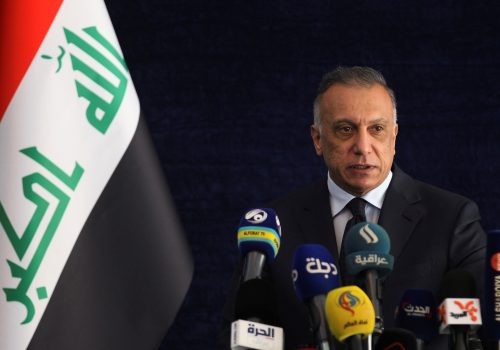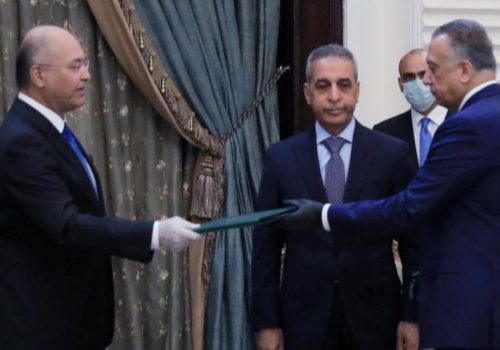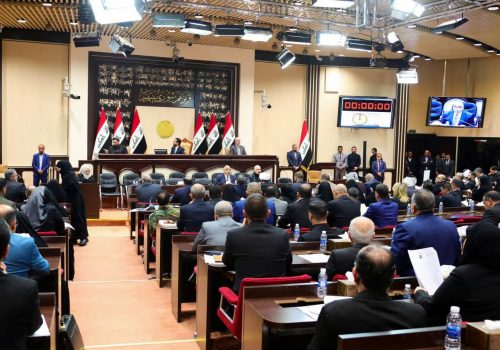The Shia are a black hole for US policy in the Middle East
It is an enduring distortion of American foreign policy that our entire experience of the Arab world and Islam is viewed through Sunni eyes. It is through our allies that the United States interprets people and events and, other than Israel, all of our Middle Eastern allies are Sunni. We often speak about democratization in the Shia majority states—particularly Lebanon, Iran, and Iraq—but have no real interface with these communities other than a simple “militia-bad; people-good” dichotomy of oppressed masses yearning to break free from oppression. Which is partially true. But we have little institutional knowledge of what those oppressed Shia masses actually want or how to engage with them. There is an urgent need for public diplomacy with the Shia community, building stakeholders with Shia religious leaders, and, above all, factoring concerns of the Shia sect into the policy process.
Since the inception of the George W. Bush administration’s global war on terrorism, the US’s focus has been on the Sunni community and preventing radicalization. This was natural given that al-Qaeda is a Sunni extremist organization, as are the majority of Islamic terror groups, including the Islamic State of Iraq and al-Sham (ISIS).
The counterterrorism machine that US General Stanley McChrystal and Lieutenant General Michael Flynn created to fight these networks is well-known. But the US also has a massive messaging component, particularly in the way it attempts to engage with Sunni communities around the world. The Global Engagement Center (GEC) at the State Department has a budget of over $60 million this year and has requested $138 million for 2021, with a great deal of counter-state programming dedicated to its Sunni work. The Office of Global Public Affairs and, one stem removed, the newly configured US Agency for Global Media, handles the light side of messaging. None of this includes the public engagement offices at the Pentagon, military commands like CENTCOM, and other agencies, which also do extensive messaging to Sunni communities overseas.
The issue is that Sunni extremists are no longer a determinative geopolitical priority. For the moment, the fire has gone out of the radicals. ISIS is not gone but has gone underground like its sister organizations. Though it can still bite, it is utterly discredited in the heartland of Iraq and Syria. ISIS pulled the Sunni world to the brink and it drew back. Outside of a catastrophic black swan event—a mass release from the al-Hol prison in Syria, a Houthi breakthrough in Yemen, some implosion in Pakistan or Afghanistan—it is not clear what would resurrect the mass political appeal of Sunni extremism.
Adding to this challenge is that the Shia community’s radicals are radical in a very different way than the Sunnis. They form the political bodies from which structured, directed militant groups emerge, but there are virtually no lone wolves. Terror, such as it exists, is carefully controlled for state ends. Lebanese Hezbollah will still conduct bombings in Israel, Syria, and Europe—like the Bulgarian attack for which it was blamed in 2012—and Iran will kill dissidents, but this is structurally a far different phenomenon than the explosion of hydra-headed Sunni radicalism that the US faced at the end of the twentieth century.
The great bureaucratic success of the Trump administration has been to make Iran the US’s top priority in the Middle East, allowing for America’s great big counter-Sunni extremist machine to shift focus to Shia groups. Iranian-backed Shia militant groups have begun to be sanctioned more regularly—even those that had fought against ISIS. President Donald Trump’s targeting of Iranian and Iran-backed targets and his administration’s increased risk tolerance of operating against such actors in battlespaces where they dominate is a signature bureaucratic achievement. Neither the State Department nor the Defense Department readily changed course.
Nevertheless, the public engagement work has not caught up with the new focus on Iran. In other words, the US lacks virtually any engagement with the Shia body politic. We normally do not host Shia religious leaders at official events, Iftar dinners, and the like, particularly not members of the Marjayiya. The Bush administration was actually forward-leaning with this: for example, sending a plane in 2007 to fly a senior Iraqi cleric to Houston for medical treatment. But, other than that (and some very quiet meetings held by myself with one or two others), there has not been much engagement with them, besides the occasional over-the-top communiqué to Grand Ayatollah Ali al-Sistani in Iraq—usually when the walls in Iraq are about to come crumbling down.
This is obviously, for Shia religious leaders, a sensitive issue. America is not beloved by the Shia clerical establishment nor by the ordinary man on the street, but of course most Shia also do not subscribe to the sort of role that the religious authorities in Qom have proscribed. Ayatollah Ruhollah Khomeini’s doctrine of Velayat-e Faqih is still embraced by a minority and there is even less sympathy in places where Iran-backed militias are actively killing other Shia, as they were in October 2019 in Iraq. However, even Shia who dislike Iran and feel no particular affinity for the Islamic Republic also dislike many of America’s regional policies and support Shia causes. It is a gray zone—a public that does not love Qom but also does not love the Saudi-led war in Yemen with US support.
And, unfortunately, virtually all of America’s policies toward the Muslim world are pro-Sunni, allowing Iran, Hezbollah, and others to offer an appeal to the Shia body politic beyond simply coercion. I have been asked several times by senior Shia politicians—including those whose fortunes Iran is actively working against—if there isn’t something the US can do to help ease the humanitarian situation in Iran due to US sanctions. They have expressed deep unhappiness with the war in Yemen and have even defended Shia militants traveling to Syria because holy Shia shrines were under siege from ISIS.
Much of this is balderdash and excuse-making by Shia politicians in order to avoid action. But there is a core US national interest that is being trampled on. There is little electoral benefit to building a good public relationship with the United States for any of these Shia political leaders, particularly in Iraq. Shia grievances limit political support for an embrace of America, even in cases where Iran’s own domestic thuggery has produced a significantly alienated populace. This forces a trade-off for any politician that wants to push back on Iran; they need international support to stop abuses by Iran, but accepting that support—American support—loses them political points with their base. And only overwhelming political support allows a politician to curb Iranian behavior.
In the event that the Trump administration secures a second term, one of the key tasks for Middle East policy will be to continue America’s shift in focus from the Sunni community to the Shia community, with engagement and messaging to go along with the sanctions and air strikes. The US could put out statements for Shia holidays like Ashura in as non-sectarian a way as possible and host events with Shia religious leaders.
The goal is not for the Shia to love the United States. That would be nice, but it is not necessary. What is necessary is for Shia bodies politic in Shia plurality states to begin to put constraints on militant action—not necessarily through confrontation and arrest, but through political fallout for their representative parties. We have somewhat seen this over the past eighteen months in Iraq. It should be a US objective to cultivate it elsewhere.
Andrew Peek is the former Deputy Assistant Secretary of State for Iraq and Iran at the US Department of State from 2017-2019.
Image: Members of Iraq's Shia militia Asaib Ahl al-Haq take part in a parade in Karbala, March 21, 2014. The militia members support Syrian President Bashar al-Assad. REUTERS/Mushtaq Muhammed


